Long-Term and Short-Term Trading: Which Style to Choose

There are different types of trading, depending on how long you hold your position in the market. Basically, traders choose between short-term trading and long-term investments. Whatever style you prefer, you can use technical analysis. By reading this article, you will find out more about both short- and long-term trading, as well as about their main advantages and disadvantages. To start trading right now, you can create an account at Binolla.
Contents
- 1 Short-Term Trading Basics
- 2 Types of Short-Term Trading
- 3 Short-Term Trading: Assets that You Can Trade
- 4 Short-Term Trading Strategies
- 5 Try trading with different trading styles!
- 6 Digital Options Trading
- 7 Long-Term Trading Basics
- 8 Position Trading
- 9 How Does Position Trading Work?
- 10 Main Strategies and Techniques
- 11 Comparing Both Short- and Long-Term Approaches
- 12 What Type of Trading Is the Best for You?
- 13 Final Words
- 14 FAQ
Short-Term Trading Basics
This type of trading or trading style refers to positions that last from several seconds to a couple of days. Short-term stock or currency trading is an alternative to long-term investment strategies where traders buy an asset and hold it for several months or even years.
Short-term trading is very popular among all categories of traders, as it allows them to capitalize on smaller price fluctuations and, theoretically, earn more money. Long-term investors consider 20-30% yearly income as a good profit, while traders may make the very same amount in a matter of days on some assets, especially when they trade volatile cryptocurrencies.
When it comes to analysis, short-term traders use technical price action and indicator strategies. Fundamental analysis is useless at this distance as it has a mid-to-long-term impact on quotes. However, short-term traders sometimes use news trading that is based on fundamentals to make money on important data releases.
Short-term trading with stocks, currencies, and other assets is referred to as active trading, which means that you will have to apply a lot of effort to succeed. That’s true, as you will have to do research, watch for reliable trading signals, open trades, and watch your results. All this should be done in a relatively short period of time, which requires honed skills.
Short-term traders often use stocks, currencies, cryptos, commodities, and other assets to earn money. Moreover, they buy CFDs, digital options, and other derivatives.
Types of Short-Term Trading
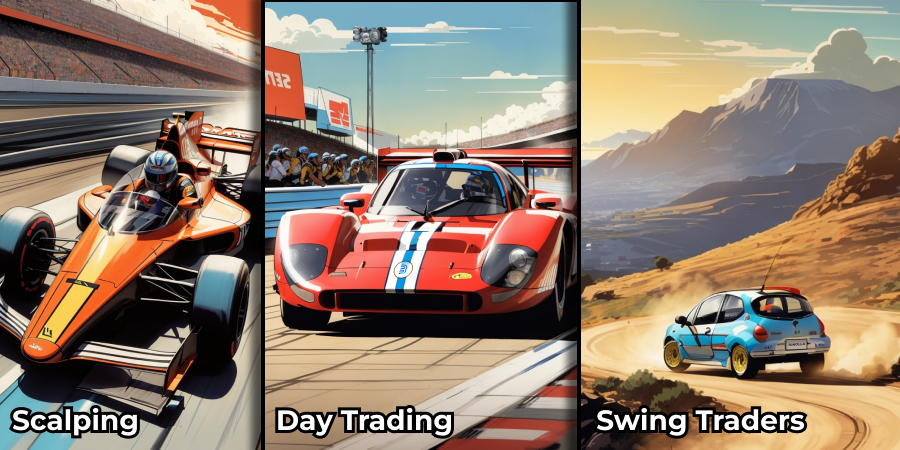
Short-term trading is a common term that includes three sub-types that will be described below.
Scalping
This is the fastest way to earn money in the financial markets. Whatever underlying asset you use—stocks, currencies, or even crypto—you can apply scalping strategies to try to generate profit from smaller price fluctuations.
Scalping refers to a whole set of strategies that use various technical analysis tools to help traders find the finest entry points, which is crucial for being successful in this type of trading. Keep in mind that every single pip matters in scalping, and losing it to the market means having fewer pips in your pocket by the end of a trade. Scalping is totally opposite to the best long-term investment strategies, where you can put hundreds of pips into your pocket, and missing a single one is not a big deal.
Scalping trading has a lot of advantages. First and foremost, it provides you with a plethora of trading opportunities throughout the day. You will be able to open dozens of positions throughout a single trading day, which means you can double and even triple your initial balance by the time you close your last trade.
However, while making huge amounts of money with scalping is theoretically possible, you should know about the other side of the moon too. Scalping is among the riskiest strategies so far. Simply imagine that you will have to open a lot of trades in a very short time.
Even if you have a good strategy and the guts to trade in this environment, a single mistake may ruin all your endeavors. Moreover, working under such gigantic pressure is not for all. Scalpers are getting tired quickly after a series of trades, and not all of them are happy about their outcomes once they close their last deal.
All-in-all, scalping can be very generous to those who are ready to work in a machine style, but even in this case, the risks are very high. Nothing guarantees that by the end of a week or even a longer distance, your profits will cover your losses, and you will be able to make money by using those strategies.
Keep in mind that Binolla offers special 5s Scalping contracts that last for 5 seconds, which allows you to trade contracts with quick outcomes.
Day Trading
As it comes from its name, this trading style refers to trading within a day. Those who use it, open and close their positions within 24 hours. Therefore, day traders open several positions throughout the day, trying to make money on small price fluctuations.
Similar to scalping, day traders are required to make fast market decisions and open several trades throughout the day. Such traders profit from huge amounts of volatility that may occur within a day.
Swing Traders
This is one of the longest short-term trading styles, which refers to trades that may last for a couple of days or even weeks. Swing traders take advantage of longer price movements, but they tend to open several positions within this larger trend. They often buy when the price goes along the main trend and sell during corrections.
Short-Term Trading: Assets that You Can Trade
Short-term trading is suitable for all types of assets. You can buy stocks, currencies, crypto coins, and even commodities within a day and sell them when you think that you can make money on the price difference.
However, you should keep in mind that short-term stock trading is possible only via digital options or CFDs. If you buy them directly from exchanges, you will spend a couple of days waiting for the stock to be transferred to you. As you can guess, you can’t sell it within this interval.
When it comes to digital options or CFDs, those contracts do not provide for the rights to be transferred, as you are not going to own the stock. Therefore, you can sell those contracts at any moment. Digital options, in turn, have an expiration, which is a moment in the future when the contract is settled automatically. You don’t even need to sell it.
The list of assets that you can trade using short-term strategies includes:
- Forex. This is one of the most popular markets for short-term trading and even for applying the best long-term investment strategies. Short-term traders value the around-the-clock trading opportunities of this market, as well as high liquidity and low commissions. The market provides enough volatility to work with various types of strategies. Keep in mind that holding positions overnight is subject to swap that may be positive or negative (except digital options, where there are no commissions at all);
- Stocks. Trading stocks is a great idea if you are using short-term strategies. When buying shares, you can expect a great variety of stocks to buy and sell. While stocks are not available 24/5, you can find your favorite volatile shares and trade them at certain hours. As it was already mentioned, the best way to trade stocks using short-term strategies is to use CFDs and digital options;
- Cryptocurrencies. This market is available 24/7, meaning you can buy and sell cryptocurrencies even on Saturdays and Sundays. This particular niche is full of volatile assets, and in some cases, the volatility is close to extreme. This creates a lot of interesting market movements that you can use to make a profit;
- Commodities and precious metals. This is another category of asset that is very popular among traders. You can buy oil, gold, and silver without receiving the rights to them, and, therefore, you can simply speculate on those assets.
Short-Term Trading Strategies
There are plenty of strategies that you can use to trade your favorite assets throughout the day. We are going to group them and provide you with a general idea about what types of tactics you can apply to buy digital options or purchase/sell various assets via CFD.
Trend Strategies
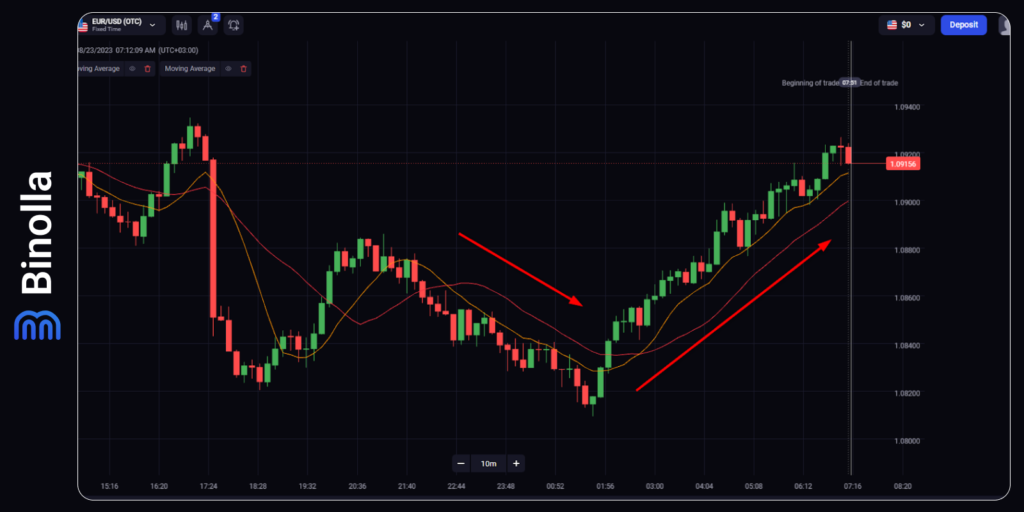
The first and most widely spread strategy is the MA crossover. The idea behind it is very simple. You add two MAs (in our example, we use MAs with 10 and 20 periods) and watch for their crossovers. If it happens above the price and both MAs go down above the price, the downtrend is dominating. You can buy Lower digital options contracts or sell an asset if you are trading CFDs.
When using this strategy, you can hold your position for some time until another crossover takes place. Once this happens, you can close your trades and find other entry points. This applies to CFD trading only, as digital options are closed automatically at the expiration point.
Range Trading
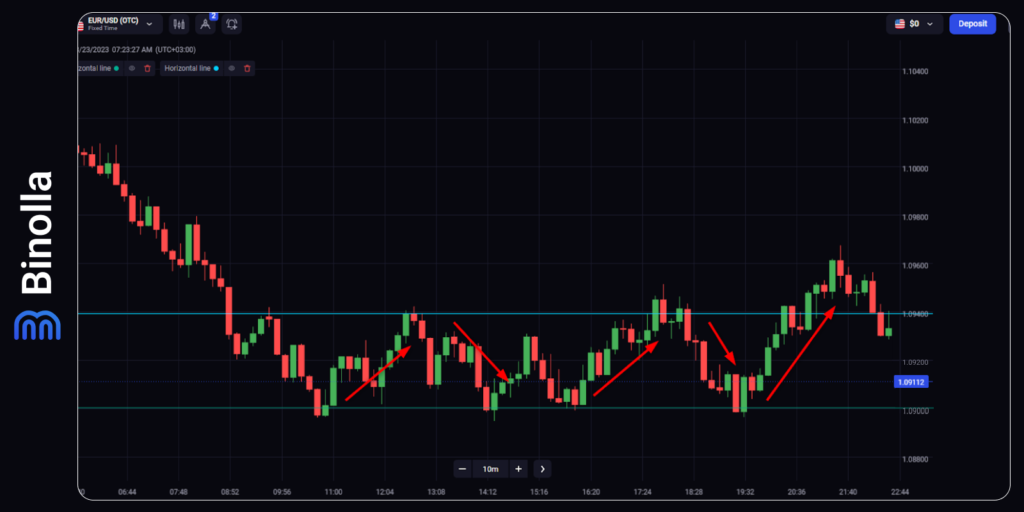
Another way to perform short-term trading is to buy and sell within a range. While long-term investors avoid range trading because they find it boring and less effective, short-term traders often use such tactics because they offer a lot of opportunities.
The idea behind these strategies is to go long when the price rejects the lower boundary and to go short when the price rejects the upper band. We have highlighted such situations with arrows in our example.
As you can see, range trading is quite an interesting approach; however, you should never forget that once a true trend starts, the price breaks one of the bands and goes higher or lower. Therefore, you will have to change your strategy in this situation.
Along with support and resistance levels, which are key tools for range trading, you will need some other technical analysis tools to make better predictions. For instance, you can use momentum indicators, especially their overbought and oversold features, to find better entry points. Japanese candlestick patterns may also be very useful when trading ranges.
Breakouts
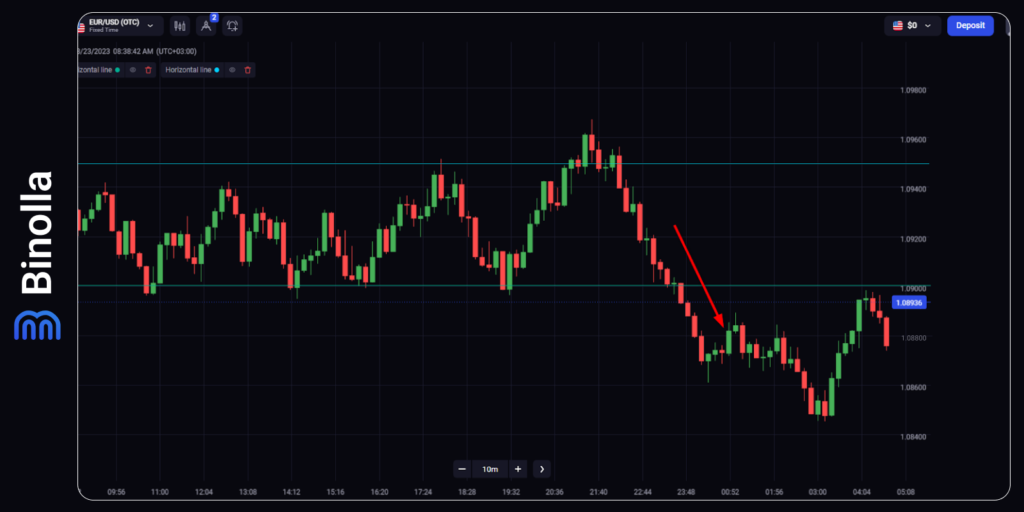
We have already mentioned that ranges are not eternal, and they end even earlier than you expect. Therefore, you should be ready for such situations, and you will be rewarded if you manage to catch the breakout.
One of the advantages of such range breakout strategies is that the momentum is huge in most cases. To break out a range, volumes are needed. And when volumes come to markets, the volatility rises and the momentum appears.
For digital options traders, this momentum is of lower importance as their income depends on whether they make the right decision about the price movement direction and not on how many pips the price covers. For CFD traders, on the other hand, distance matters, and breakouts offer great opportunities to make more money with a couple of candlesticks.
Reversals
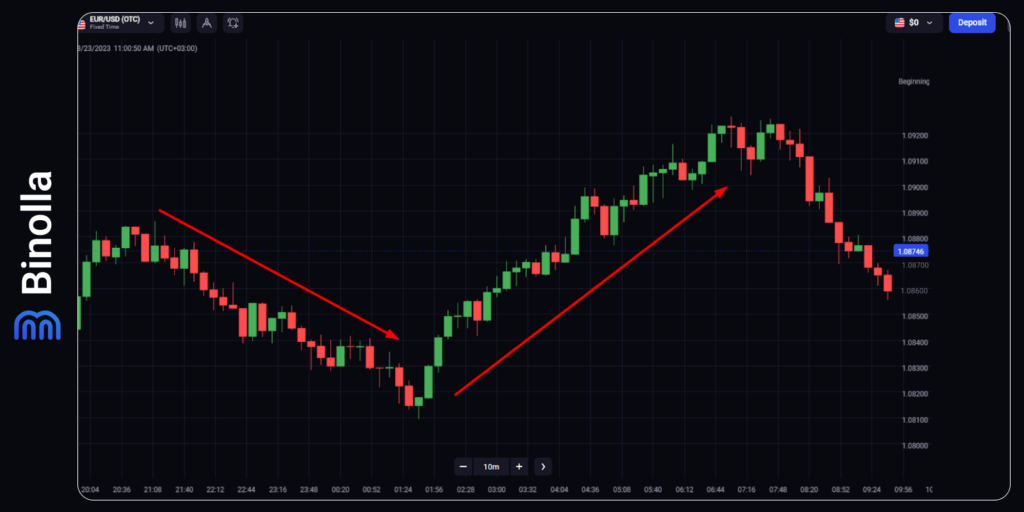
Market reversals are a great opportunity to find entry points and make money. These are situations when the trend changes from one to another. In the example above, the downtrend ended and once a green bullish hammer appeared, the uptrend started.
To trade those strategies, you can use candlestick patterns, as they offer you a lot of opportunities to find reversals in stocks, currencies, cryptocurrencies, and commodities. However, there are many other options, as you can use various indicators, including oscillators, to find the point where the previous trend is exhausted and a new one will start to evolve.
Keep in mind that this type of strategy has one serious risk. Many indicators, as well as patterns, are not able to distinguish the difference between a correction and a new trend. It is not a big deal when you are trading digital options, as those are short-term contracts, and even if you catch a correction instead of a true reversal, your chances of making money are very high.
However, if you are trading CFDs and expect a short-term trend to develop, you should make sure that this is a true trend movement and not a simple correction to the previous trend.
Digital Options Trading
Now that you know more about short-term strategies, it is time to get familiar with a form of financial contract that may be very interesting to you. Digital options or fixed-time contracts are among the short-term derivatives that you can choose from the Binolla platform. This type of financial instrument allows you to purchase special contracts and try to predict the direction of the price movement to make money.
Digital options are short-term derivatives, as their expiration does not exceed 24 hours in most cases. They are used by traders to perform trades within small time intervals in order to make money on small price fluctuations. However, by trading those contracts, you can earn up to 95% per trade, which is one of the greatest advantages of this form of trading.
To trade those contracts, you need to:
- Conduct market analysis and reveal current short-term trends and trading opportunities.
- Decide how much to invest in one trade.
- Define the amount of the investment depending on your money management strategy.
- Choose the direction of the trade (Higher or Lower).
After you place a trade, you need to wait for the expiration time to occur to see the results.
Long-Term Trading Basics

Unlike short-term trading, long-term investment strategies involve buying and holding stocks or other assets for months or even years. Here, you have two alternatives.
Investments
The best long-term investments are made with the purpose of holding a stock to earn dividends. Those are payments that a company makes to its shareholders from time to time. Those who buy stocks for investment purposes often hold them until the dividends are paid, or at least until the amount of the dividends is satisfactory for a particular investor.
Once they decide that the dividends are below their expectations or the company ceases to pay them, investors get rid of the stock, trying to sell it at the most appropriate price and making money on the difference between the initial and current quotes.
Trading
Long-term trading’s main idea is to solely earn on the price difference. You buy a particular asset, you hold it for some time, and you sell it. The purpose is the same as with short-term trading, but this time, you hold a stock or a currency for a longer period of time.
Position Trading
You may have heard about position trading strategies that some traders use in their trading routines. Position trading is similar to long-term trading and involves buying a particular asset, be it stocks, currencies, or cryptos, and selling them when a trader decides that he can make enough money from this operation.
One of the examples of the longest trade was recorded in the United States. An unnamed trader bought the S&P 500 index in 1991 and closed the trade in 2000 only. Their position was active for almost ten years.
How Does Position Trading Work?
Unlike short-term trading, the best long-term investment strategies require time for profits to grow. Position traders always catch long-term trends and benefit from them by putting a lot of pips in their pockets. This trading style does not require immediate decisions, as you can join the trend after a reversal and have enough time to make sure whether it is confirmed or not.
On the other hand, some assets may stay dormant for a long period of time. If you think that they are going to “wake up” after some news releases or events in the future, you can buy them while they are in range and hold this position until the future trend is over.
Main Strategies and Techniques
Unlike short-term trading, where technical analysis is dominant, in long-term trading both technical and fundamental types of analysis are applicable. Therefore, there are three main types of strategies that you can use for stocks, currencies, cryptos, and other assets.
Technical Strategy
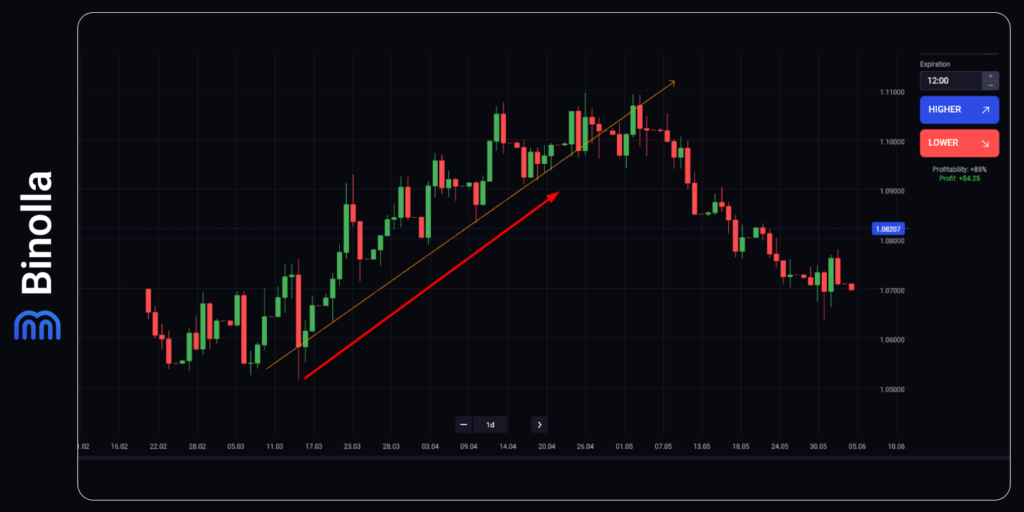
The idea of such strategies is to catch a bigger trend and benefit from it. Here is the easiest way to find entry points. You simply need to build a trend line and open trades once the price hits it again. Hold your positions until the trend line is broken.
This is a very simple strategy, but you may need some more tools to make it even more effective. First, you can use some indicators in order to find precise entry points. Second, you can add candlestick patterns to make sure that the price rejects the trendline if there are fake breakouts.
When it comes to stocks, you can try to use real volumes to understand that the trend is supported by real money flow and see when the trend is exhausted if the volumes decline.
Fundamental Strategy
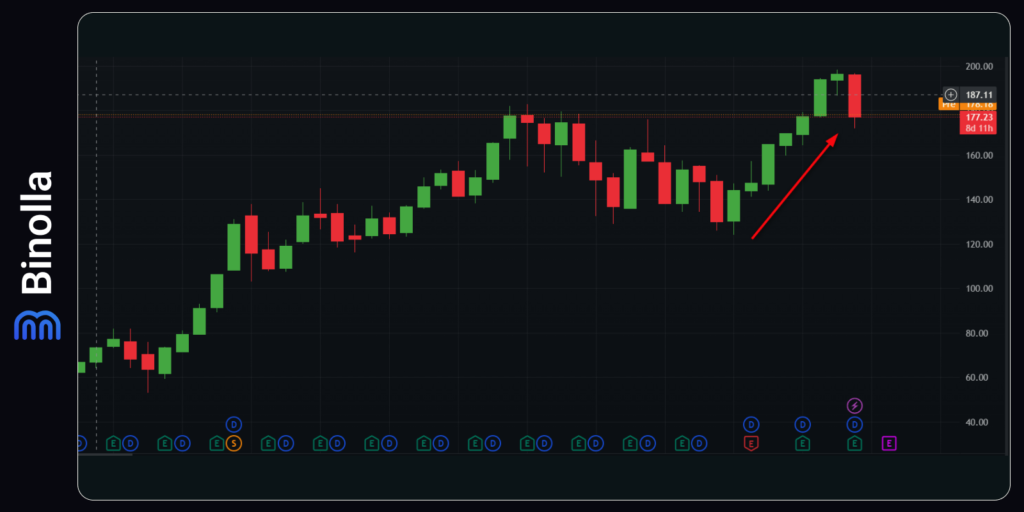
This is a more complex approach that requires knowledge of economics and an understanding of how it influences financial markets. The image above shows the EUR/USD monthly chart. You can see the uptrend that restarted after almost a year of a correction. This uptrend was due to the difference between the monetary policies of the European Central Bank and the Fed. Moreover, market participants expect the ECB to continue monetary policy tightening even after the Fed stops hiking rates.
What does it mean for the markets? EUR is likely to show better performance against USD in the future, and the uptrend may continue with corrections on its way. However, anyway, the best long-term investment strategies suggest buying EUR against USD and holding it for some time.
Combined Strategy
Another way to use the best long-term investment strategies is to combine technical and fundamental analysis types. In this case, traders use fundamentals to forecast long-term trends and add technicals to find entry points. This is the best approach, as it allows you to consider both price drivers and chart situations and find refined entry points.
Comparing Both Short- and Long-Term Approaches
Now that you know how both types of trading work, it is time to compare them and define their advantages and disadvantages for you to make a decision on which one to apply (or even choose both of them in your trading routine).
| Short-Term Trading | Long-Term Trading |
| All trades are placed and closed within 1-2 days in general | This approach uses Buy&Hold strategy, which means you can stay in the market for months and even years |
| You need better reaction and refined strategies as entry points should be as neat as possible as every pip counts | You don’t need to make quick decisions and have enough time to watch the trend to develop and to see whether the current price movement direction is confirmed |
| Traders can use technical analysis only. However, they can also use fundamentals to trade important news | Both fundamental and technical analysis are applicable. The best strategies include both analysis types |
| Traders take higher risks as they have to open more positions within a shorter time interval | Long-term investment and trading is less risky as you open one or several positions and hold them for a longer interval |
| Short-term trading is considered the best way to make fast money as you trade a lot in a short distance | To make considerable profits, traders are required to put more money at risk. |
What Type of Trading Is the Best for You?
This is a very personal question, and everyone has their own answer. A lot of professional traders prefer short-term trading as it allows them to engage with lower amounts of money and make significant profits over time.
However, if you choose this way, you should make some key preparations. First, short-term trading requires a good reaction. You will have to sit in front of your laptop or with your mobile device in your hands and watch for signals. Therefore, you should have a good strategy or even several ones at hand first.
Those who prefer short-term trading should be prepared to make this work every day. Thus, you need to devote some time that you can dedicate solely to trading and be free of any obligations. This will allow you to focus on your trading routine and find good entry points.
On the other hand, when trading short-term digital options, or CFDs, you will have a lot more opportunities. Moreover, you will be able to start with smaller amounts and, if your strategy is good enough, make substantial money in a relatively short interval.
Those who choose a position or long-term trading and investment strategies can benefit from larger trends. If you are using CFDs in your trading journey, then this style is a good opportunity to catch significant price movements.
Moreover, long-term trading is not as risky as short-term trading. You can place broader stop-losses and look for targets that are at a greater distance. It may seem that this approach is ideal, but it has some disadvantages too.
First, you can’t make a lot of money if you invest the same amount that you would have invested when using short-term strategies. Therefore, starting with $100, for instance, will bring you morale satisfaction by the end of the year if you have predicted the direction of the trend. However, your financial status will remain the same. Thus, it is better to start with more substantial investments. Many position traders invest from $10,000 and more.
Second, long-term trading requires knowledge of fundamental analysis. You may not apply it to your strategies, but knowing the reasons for the price to trend is crucial for success. Finally, the cost of mistakes in position trading is much higher as stop-losses are wider.
Before using any approach, you should think about the risk/reward ratio. The more money you put at risk, the more you should get as a reward from the financial markets. If you use short-term strategies, for instance, you can make a lot of money even within a week. But risks are also higher as compared to long-term strategies. Therefore, you can diversify your strategies by adding other short-term tactics or even some long-term methods.
Knowing all the above, you can choose your trading style. Keep in mind that using short-term strategies does not go in contradiction with long-term trading. You can apply both without any limitations. For instance, you can devote part of your capital to buy FX pairs short term and purchase stocks to hold them with another part of your balance.
Final Words
Whatever type of trading you choose, you should never forget that both require knowledge and skills. Even if you decide to join a trend that is developing, you should understand where to leave the market.
You should prepare yourself for every type of trading and work on your strategies. It is recommended to use the demo to practice a bit before trading for real money.
FAQ

What Is Short-Term Trading?
This is a type of trading that involves buying and selling assets within 24 hours or a couple of days. There are several strategies that you can apply, including scalping, day trading, swing trading, etc.
What Is the Best Timeframe for Trading?
Traders choose timeframes according to their strategies. For instance, if you use scalping strategies, you can choose between seconds and minutes timeframes. Intraday traders often use hourly timeframes.
What Is Considered Long-Term Trading?
Traders who use those strategies hold positions for several months and even several years. One of the most famous long-term trades lasted for almost ten years.
What Is the Difference Between Short- and Long-Term Trading?
Short-term trading refers to trades that are held within 24 hours. Rarely do traders hold positions for a couple of days. As for long-term trading, traders hold their positions for months and even years.
Is Long-Term Trading Better?
When trading long-term strategies, you should keep in mind that both technical and fundamental analysis should be applied. Therefore, if you are ready to use them both, you can try. Moreover, you should keep in mind that it is better to put more money at risk to have higher profits.







